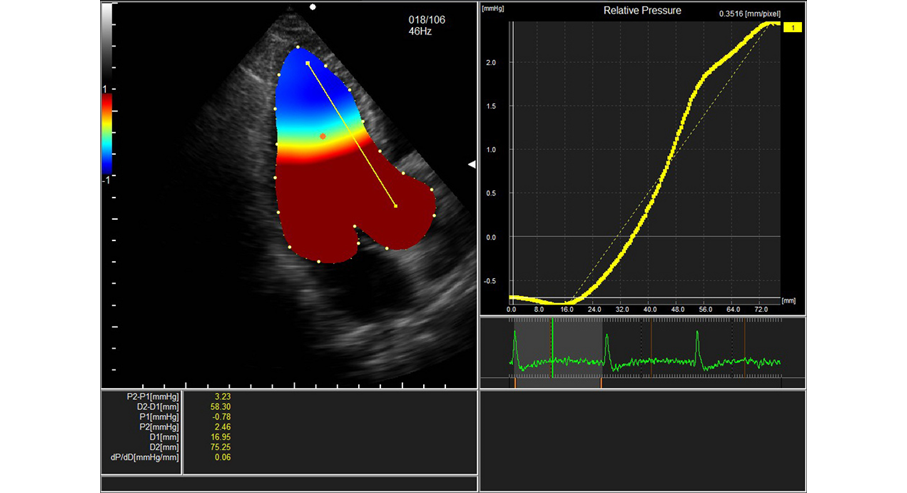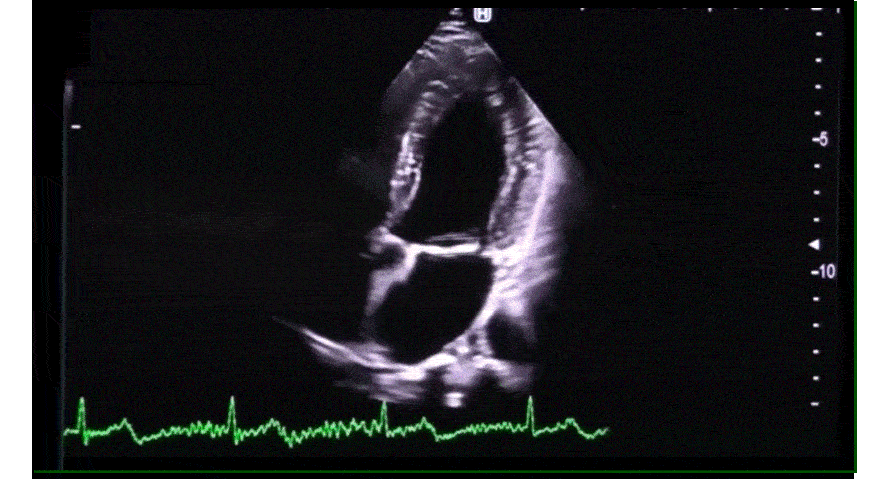This webpage content is intended for Healthcare Professionals only, not for general public.
Redefining the Vision of Cardiovascular Ultrasound
Heart disease pathologies can be slow in showing their signs, making it a silent deadly killer accounting for one third of all global deaths. From fetal to elderly care, early detection remains crucial, and Fujifilm is dedicated to help clinicians achieve that with highly specialized ultrasound solutions that detects early signs of heart failure, 3D/4D visualization for detailed diagnosis of cardiac functions, and quick quantifiable tools for consistent results across all generations.
High Quality Cardiac Imaging
Above all, an excellent 2D image quality that captures the subtlest of details is the basis of all accurate and confident diagnosis.
eFocusing

Fujifilm's dynamic auto-focusing technology, combined with fast parallel beamforming, removes the need to adjust focal points manually. As you scan, homogeneous images with excellent S/N and spatial/contrast resolution can be achieved without compromise on frame rate.
Carving

Clear and sharp images are key to a reliable cardiac scan. Our premium Carving technology pinpoints even the lightest echoes to enhance organ boundaries. Take your diagnosis to the edge with crystal-clear views of the myocardial borders, apical walls and valves.
Colour Doppler

Unlike conventional Colour Doppler modes wherein frames get missed (due to quick heart movement) thus images may not mirror actual blood flow, Fujifilm's innovative Colour Doppler can maintain a high frame rate with high resolution to ensure that no suspicious signs are missed when evaluating blood flows.
HDAnalytics for Early Heart Failure Diagnosis

❤️ Virtual Contrast

Unique to Fujifilm, this high definition blood flow mode helps clinicians measure systolic function easily, even in difficult patients like the elderly or those with high BMI. The endocardial border of the left ventricle can be delineated, delivering clear images of the fully filled LV cavity.
Virtual contrast can be used as an non-invasive alternative to contrast agents, with results comparable to MRI.
❤️ Dual Gate Doppler (D.G.D)

Especially useful in assessing patients with arrhythmia, our Dual Gate Doppler measures two separate waveforms from the same heart cycle at the same time (using PW, TDI or both simultaneously). Not only can clincians benefit from an easier evaluation of dyssynchrony in septal and lateral walls, the use of data from the same cycle improves measurement accuracy of E/e', IVRT, and IVCT indices.
❤️ Vector Flow Mapping (VFM)

Moving beyond Colour Doppler imaging, Fujifilm developed the world's first Vector Flow Mapping to visualize and quantify hemodynamics in all directions with new echo parameters. From one cine loop, flow direction (without angle dependency), vorticity, energy loss, wall shear stress, and relative pressure can be appraised to detect early signs of heart failure.
Studies have shown VFM to be comparable to CMR and Echo-PIV in the evaluation of cardiac workload especially in cardiomyopathy, pre- and post-cardiac surgery.

Non-invasive measurement of the relative pressure in the LV cavity
Most clinics use a catheter to measure the pressure in the left-ventricular cavity. But VFM offers a non-invasive approach to calculate the relative pressure gradient just by conducting an echoscan. Simply draw a line and click a button to get various pressure indices, like mmHg. The suction function in the isometric relaxation period is displayed in a pressure colour map - all of which contributes to easy assessment of diastolic function and quick evaluation of heart failure risk.

Assess energy loss at turbulences to check treatment response
Turbulent blood flows in the left ventricle can be caused by stenosis or complications after surgery. VFM detects and characterises these flows by assessing the energy loss they cause: the more energy lost, the higher the turbulence. Studying energy loss – for example in patients with aortic insufficiency, or as follow-up before and after mitral valve treatment – has also proved useful in understanding hemodynamics.
Quick and Precise Exams with A.I.


🔎 Automated Measurements
Your data can just be one click away! Simply apply different parameters to the normal B-mode image and our system will generate highly precise cardiac measurements based on our HemoDynamic Structural Intelligence (HDSI).

🔎 Auto Ejection Fraction
Our AI technology automatically recognizes optimal diastolic and systolic frames, and measures the EF based on the Simpson method.

🔎 Stable R-R intervals
Manually selecting stable R-R intervals can be challenging especially in patients with arrhythmia. Our next level iDual Gate Doppler (iDGD) can help you do so automatically, measuring PW/TDI in the same heart cycle and calculating E/e' in just 5 seconds.
Advanced Echocardiography Application


📍 Better understand structural anormalies with 3D and Bi-plane views
Not only does our high-resolution 3D/4D images help improve the visualization of valve structures and thrombus, you can also save examination time as 2D images can be obtained from multiple planes by manipulating the volume data, without compromise on image quality.
You can access the 3D volume reconstruction offline after the exam to analyse the details for a confident diagnosis and treatment plan.

📍 Quantify mitral valve anatomy to guide treatment decisions
For complex mitral valve pathologies like a prolapse, you need a detailed assessment to decide and prepare the right therapy. With 4D MV Assessment*, you can analyse and quantify its anatomy and movement.
Set reference points on the 3DTEE image and automatically obtain important geometric measurements like annular dimensions, leaflet morphology, or coaptation descriptions. Then, use this data to plan your patient's therapy and monitor treatment response.

📍 Visualize and quantify the full LV function in 3DTTE
4D LV-ANALYSIS* can assess the left ventricular function based on 3D speckle tracking. This innovative research approach displays the regional and global strain analysis via a 3D model of the LV that visualizes the wall motions comprehensively; while a colour-coded bullseye highlights healthy and problematic areas in different segments. In all, it gives you a better understanding of wall motion anormaly and cardiac function.

📍 RV function assessment without use of MRI
The right ventricle can be difficult to assess in 2D ultrasound, which is why most patients get referred for MRI. However, recent studies have shown that 3D echocardiography delivers similar results to MRI - quicker and easier.
4D RV FUNCTION* analyses and quantifies RV function for cases like pulmonary hypertension, or right-sided heart failure; it enables you to combine 3D and 2D values including EDV, EDVi, ESV, ESVi, EF, and SV, RVLS, TAPSE, and FAC - all from the same volume dataset.












![[photo] DeepInsight - Redefining the way we see](https://asset.fujifilm.com/www/my/files/styles/1120x200/public/2024-09/e2951cfb180d4db419cf331f2bebf0e9/bnr_deepinsight_pc.jpg?itok=DF-Uqd16)